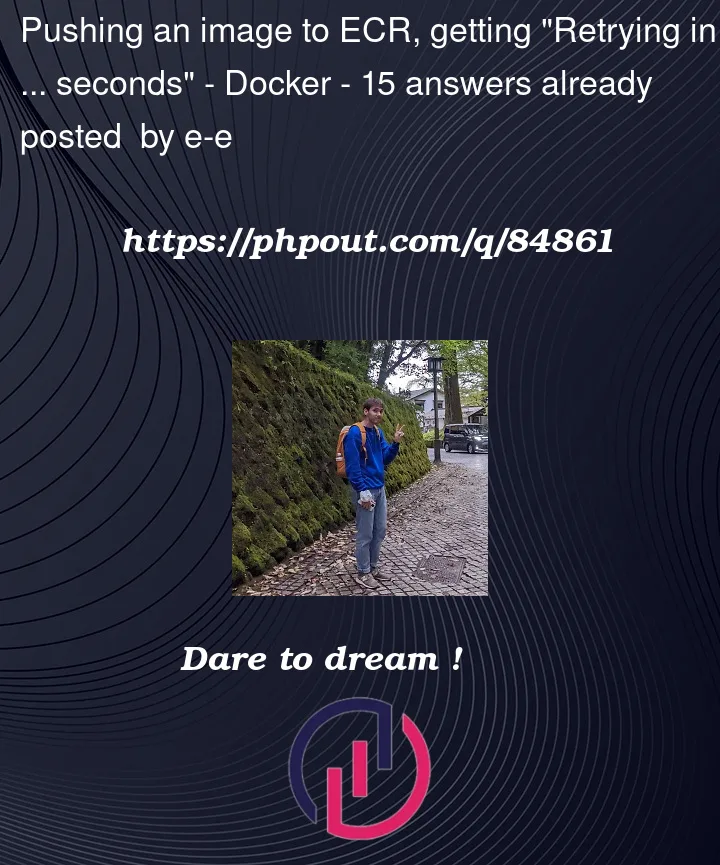I recently created a new repository in AWS ECR, and I’m attempting to push an image. I’m copy/pasting the directions provided via the "View push commands" button on the repository page. I’ll copy those here for reference:
aws ecr get-login-password --region us-west-2 | docker login --username AWS --password-stdin 123456789.dkr.ecr.us-west-2.amazonaws.com
("Login succeeded")
-
docker build -t myorg/myapp . -
docker tag myorg/myapp:latest 123456789.dkr.ecr.us-west-2.amazonaws.com/myorg/myapp:latest -
docker push 123456789.dkr.ecr.us-west-2.amazonaws.com/myorg/myapp:latest
However, when I get to the docker push step, I see:
> docker push 123456789.dkr.ecr.us-west-2.amazonaws.com/myorg/myapp:latest
The push refers to repository [123456789.dkr.ecr.us-west-2.amazonaws.com/myorg/myapp]
a53c8ed5f326: Retrying in 1 second
78e16537476e: Retrying in 1 second
b7e38d172e62: Retrying in 1 second
f1ff72b2b1ca: Retrying in 1 second
33b67aceeff0: Retrying in 1 second
c3a550784113: Waiting
83fc4b4db427: Waiting
e8ade0d39f19: Waiting
487d5f9ec63f: Waiting
b24e42eb9639: Waiting
9262398ff7bf: Waiting
804aae047b71: Waiting
5d33f5d87bf5: Waiting
4e38024e7e09: Waiting
EOF
I’m wondering if this has something to do with the permissions/policies associated with this repository. Right now there are no statements attached to this repository. Is that the missing part? If so, what would that statement look like? I’ve tried this, but it had no effect:
{
"Version": "2008-10-17",
"Statement": [
{
"Sid": "AllowPutImage",
"Effect": "Allow",
"Principal": {
"AWS": "arn:aws:iam::123456789:root"
},
"Action": "ecr:PutImage"
}
]
}
Bonus Points:
I eventually want to use this in a CDK CodeBuildAction. I was getting the same error as above, so I check to see if I was getting the same result in my local terminal, which I am. So if the policy statement needs to be different for use in the CDK CodeBuildAction those details would be appreciated as well.
Thank you in advance for and advice.




15
Answers
It turns out it was a missing/misconfigured policy. I was able to get it working within CodeBuild by adding a role with the
AmazonEC2ContainerRegistryPowerUsermanaged policy:I was having the same problem when trying to upload the image manually using the AWS and Docker CLI. I was able to fix it by going into ECR -> Repositories -> Permissions then adding a new policy statement with
principal:*and the following actions:Be sure to add more restrictive principals. I was just trying to see if permissions were the problem in this case and sure enough they were.
The problem is your iam-user have not permission to full access of ecr so attach below policy to your iam-user.
follow photo for policy attachment
I had this issue when the repository didn’t exist in ECR – I assumed that pushing would create it, but it didn’t.
Creating it before pushing solved the problem.
The accepted answer works correctly in resolving the issue. However, as has been mentioned in the answer, allowing
principal:*is risky and can get your ECR compromised.Be sure to add specific principal(s) i.e. IAM Users/Roles such that only those Users/Roles will be allowed to execute the mentioned "Actions". Following JSON policy can be added in Amazon ECR >> Repositories >> Select Required Repository >> Permissions >> Edit policy JSON to get this resolved quickly:
For anyone running into this issue, my problem was having the wrong AWS profile/account configured in my AWS cli.
run
aws configureand add the keys of the account having access to ECR repository.If you have multiple AWS accounts using the cli, then check out this solution.
The same message ("Retrying in … seconds" in loop) may be seen when running "docker push" without first creating the corresponding repo in ECR ("myorg/myapp" in your example). Run:
Just had this problem. It was permission related. In my case I was using CDKv2, which assumes a specific role in order to upload assets. Because the user I was deploying as did not have permission to assume that role, it failed. The hint was these warning messages that appeared during the deploy:
Yes, updating the permissions on your ECR repo would fix it, but since CDK is supposed to maintain this for you, the proper solution is to allow your user to assume the CDK role so you don’t need to mess with ECR permissions yourself.
In my case I did this by granting the
sts:AssumeRolepermission for the resourcearn:aws:iam::*:role/cdk-*. This allowed my user to assume both the file upload role and the image upload role.After granting this permission, the CDK errors about being unable to assume the role went away, and I was able to deploy successfully.
For me, the problem was that the repository name on ECR had to be the same as the name of the app/repository I was pushing. Tried all fixes here, didn’t work. This did!
In my case, the repo was not created on ECR. Creating it fixed it.
Browse ECR -> Repositories -> Permissions
Edit JSON Policy.
Add these actions.
And Add "*" in Resources.
Save it.
You’re good to go, Now you can push the image to ECR.
If you have MFA enforcement policy on your account that might be the problem because you have to have a token for getting action. Take a look at this AWS document to get a token on CLI.
I was uploading from EC2 instance and I was missing to specify the region to my awscli, the login was successful but the docker push command was Retrying all the time, I have set the correct permissions on the ECR repo side
This line fix the issue for me and
aws configure set default.region us-west-1
In my case I used wrong AWS credentials and
aws configurewith correct credentials resolved the issue.In my case, it was causing this error due to the wrong syntax. This is the correct syntax that solved the issue in my case:
I had the correct image name written in the command but did not write the right repository name. And because of that, it couldn’t find the right repository which caused the failure in pushing the image.